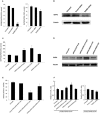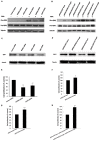Bidirectional regulation between WDR83 and its natural antisense transcript DHPS in gastric cancer
- PMID: 22491477
- PMCID: PMC3434345
- DOI: 10.1038/cr.2012.57
Bidirectional regulation between WDR83 and its natural antisense transcript DHPS in gastric cancer
Abstract
Natural antisense transcripts (NATs) exist ubiquitously in mammalian genomes and play roles in the regulation of gene expression. However, both the existence of bidirectional antisense RNA regulation and the possibility of protein-coding genes that function as antisense RNAs remain speculative. Here, we found that the protein-coding gene, deoxyhypusine synthase (DHPS), as the NAT of WDR83, concordantly regulated the expression of WDR83 mRNA and protein. Conversely, WDR83 also regulated DHPS by antisense pairing in a concordant manner. WDR83 and DHPS were capable of forming an RNA duplex at overlapping 3' untranslated regions and this duplex increased their mutual stability, which was required for the bidirectional regulation. As a pair of protein-coding cis-sense/antisense transcripts, WDR83 and DHPS were upregulated simultaneously and correlated positively in gastric cancer (GC), driving GC pathophysiology by promoting cell proliferation. Furthermore, the positive relationship between WDR83 and DHPS was also observed in other cancers. The bidirectional regulatory relationship between WDR83 and DHPS not only enriches our understanding of antisense regulation, but also provides a more complete understanding of their functions in tumor development.
Figures







Similar articles
-
SNPs detection in DHPS-WDR83 overlapping genes mapping on porcine chromosome 2 in a QTL region for meat pH.BMC Genet. 2013 Oct 8;14:99. doi: 10.1186/1471-2156-14-99. BMC Genet. 2013. PMID: 24103193 Free PMC article.
-
Small RNAs and the regulation of cis-natural antisense transcripts in Arabidopsis.BMC Mol Biol. 2008 Jan 14;9:6. doi: 10.1186/1471-2199-9-6. BMC Mol Biol. 2008. PMID: 18194570 Free PMC article.
-
eIF5A-Independent Role of DHPS in p21CIP1 and Cell Fate Regulation.Int J Mol Sci. 2021 Dec 7;22(24):13187. doi: 10.3390/ijms222413187. Int J Mol Sci. 2021. PMID: 34947982 Free PMC article.
-
[Non-coding Natural Antisense RNA: Mechanisms of Action in the Regulation of Target Gene Expression and Its Clinical Implications].Yakugaku Zasshi. 2020;140(5):687-700. doi: 10.1248/yakushi.20-00002. Yakugaku Zasshi. 2020. PMID: 32378673 Review. Japanese.
-
Natural antisense transcripts regulate gene expression in an epigenetic manner.Biochem Biophys Res Commun. 2010 May 28;396(2):177-81. doi: 10.1016/j.bbrc.2010.04.147. Epub 2010 May 8. Biochem Biophys Res Commun. 2010. PMID: 20438699 Review.
Cited by
-
Behavioral innovation and genomic novelty are associated with the exploitation of a challenging dietary opportunity by an avivorous bat.iScience. 2022 Aug 17;25(9):104973. doi: 10.1016/j.isci.2022.104973. eCollection 2022 Sep 16. iScience. 2022. PMID: 36093062 Free PMC article.
-
The Functional Meaning of 5'UTR in Protein-Coding Genes.Int J Mol Sci. 2023 Feb 3;24(3):2976. doi: 10.3390/ijms24032976. Int J Mol Sci. 2023. PMID: 36769304 Free PMC article. Review.
-
The interaction of lncRNA EZR-AS1 with SMYD3 maintains overexpression of EZR in ESCC cells.Nucleic Acids Res. 2018 Feb 28;46(4):1793-1809. doi: 10.1093/nar/gkx1259. Nucleic Acids Res. 2018. PMID: 29253179 Free PMC article.
-
Natural antisense transcripts as therapeutic targets.Drug Discov Today Ther Strateg. 2013 Fall;10(3):e119-e125. doi: 10.1016/j.ddstr.2013.03.001. Drug Discov Today Ther Strateg. 2013. PMID: 25580147 Free PMC article. No abstract available.
-
Epidemiological, Clinical, and Genomic Profile in Head and Neck Cancer Patients and Their Families.Biomedicines. 2022 Dec 17;10(12):3278. doi: 10.3390/biomedicines10123278. Biomedicines. 2022. PMID: 36552033 Free PMC article.
References
Publication types
MeSH terms
Substances
LinkOut - more resources
Full Text Sources
Other Literature Sources
Research Materials
Miscellaneous

